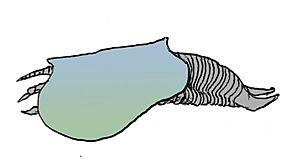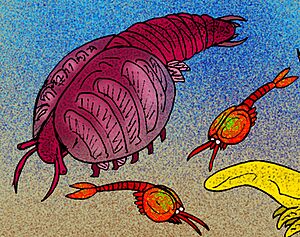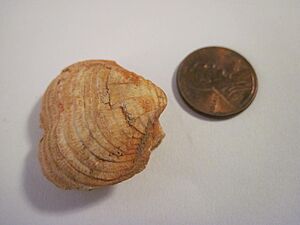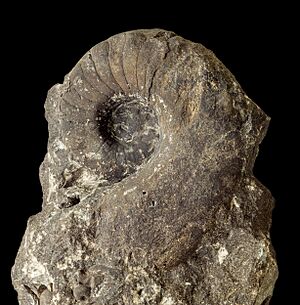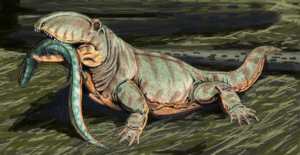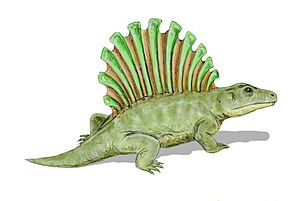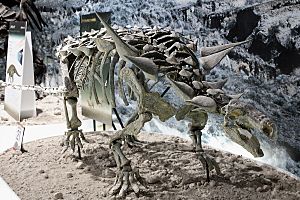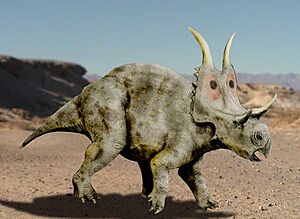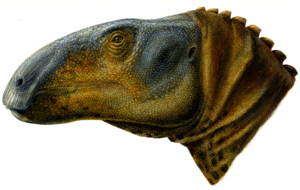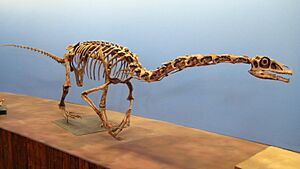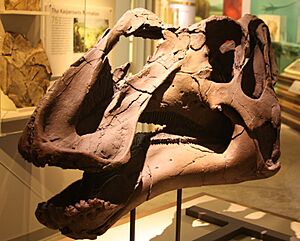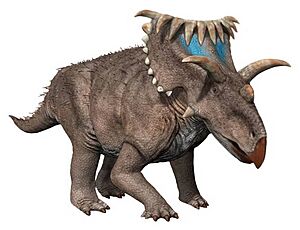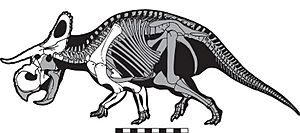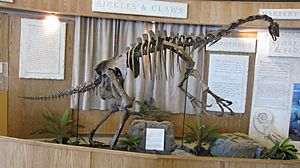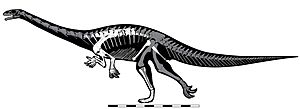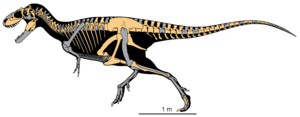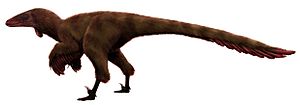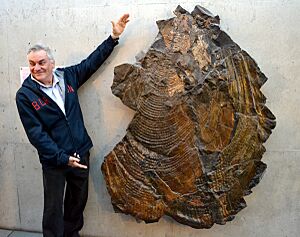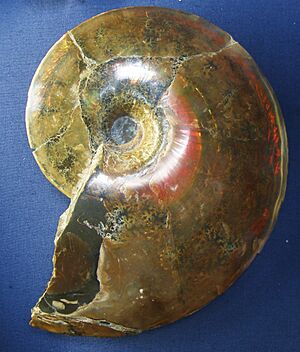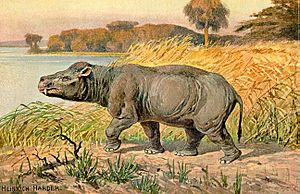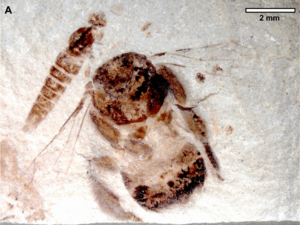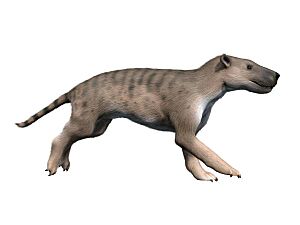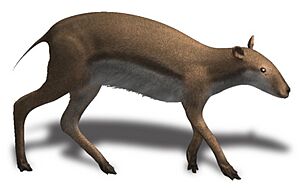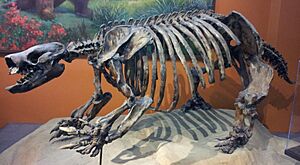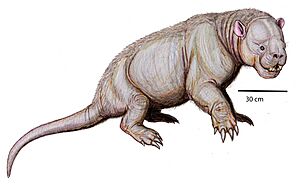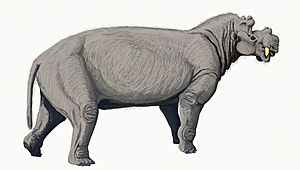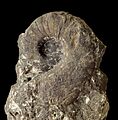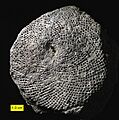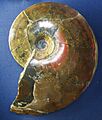List of the prehistoric life of Utah facts for kids
This list of the prehistoric life of Utah tells us about all the amazing ancient creatures and plants whose fossils have been found in the state of Utah. Utah is a super cool place for finding fossils because it has rocks from many different time periods!
Ancient Eras and Utah's Fossils
Utah's rocks hold secrets from billions of years ago. Scientists study these fossils to learn about life long before humans existed. These ancient times are split into big eras: the Paleozoic, Mesozoic, and Cenozoic.
Precambrian: Earth's Earliest Life
The Precambrian era was the very beginning of life on Earth. It lasted for billions of years! During this time, the first simple life forms appeared, like tiny bacteria and algae. However, scientists haven't found any known Precambrian fossils in Utah. This means the rocks from that time might not have preserved these tiny creatures, or they haven't been discovered yet.
Paleozoic Era: Life Explodes in the Seas
The Paleozoic Era, often called the "Age of Ancient Life," started about 541 million years ago. During this time, Utah was often covered by warm, shallow seas. This is why many fossils from this era are of sea creatures!
Amazing Paleozoic Creatures of Utah
Many different kinds of animals lived in Utah's ancient seas. Here are a few cool examples:
- †Asaphiscus: This was a type of trilobite, an ancient sea creature with a hard, segmented shell. Trilobites are often called the "bugs of the sea." They are very common fossils in Utah.
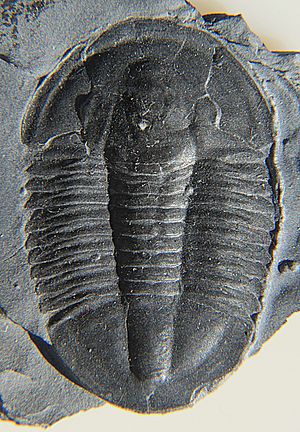
- †Anomalocaris: Imagine a giant shrimp-like creature that was a top predator in the Cambrian seas! Anomalocaris was one of the largest animals of its time.
- †Branchiocaris: This mysterious creature looked a bit like a clam with legs. It was an arthropod, related to modern-day crabs and insects.
- †Canadaspis: Another ancient arthropod, Canadaspis was a small, shrimp-like animal that swam in the oceans. It had a two-part shell covering its body.
- †Composita: This was a type of brachiopod, a shelled animal that looks a bit like a clam but is actually different. They lived attached to the seafloor.
- †Helicoprion: This ancient shark relative had a very unusual "tooth whorl" that looked like a circular saw blade. It's one of the most unique fossil finds!

- †Metacoceras: This creature was a nautiloid, a type of cephalopod related to modern-day squid and octopuses. It had a coiled shell.
- †Eryops: Moving onto land, Eryops was a large, crocodile-like amphibian. It lived in swamps and hunted fish and other small animals.
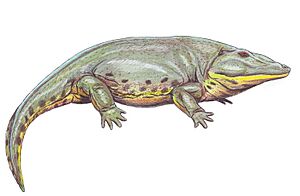
- †Ophiacodon: This was an early reptile-like animal, a "mammal precursor." It had a long snout and lived during the Carboniferous and Permian periods.
- †Platyhystrix: This amphibian had a tall, sail-like fin on its back, much like some dinosaurs. Scientists think the sail might have helped it control its body temperature.
- †Tseajaia: This was a very early reptile that lived in Utah. It's important because its fossils help us understand how reptiles evolved.
- †Utaherpeton: This small amphibian is special because its fossils were first found right here in Utah! It helps scientists learn about early land animals.
Mesozoic Era: The Age of Dinosaurs
The Mesozoic Era, which began about 252 million years ago, is famous for being the "Age of Dinosaurs." Utah was home to many different kinds of dinosaurs, from giant plant-eaters to fierce predators!
Dinosaurs and Other Mesozoic Life in Utah
Utah's deserts and mountains today were once lush environments where dinosaurs roamed.
- †Allosaurus: This was a large, meat-eating dinosaur, one of the most common predators of the Late Jurassic period. It had sharp teeth and claws.
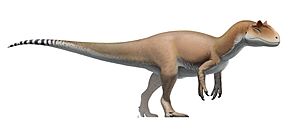
- †Animantarx: This was an armored dinosaur, a type of ankylosaur. It was covered in bony plates and spikes for protection. Its name means "living fortress."
- †Apatosaurus and †Brontosaurus: These were massive, long-necked sauropod dinosaurs, some of the largest animals to ever walk the Earth. They ate huge amounts of plants.
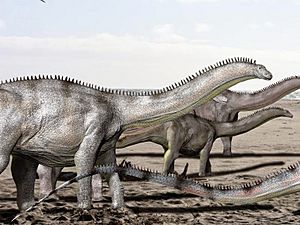
- †Camarasaurus: Another large sauropod, Camarasaurus was a common plant-eater in the Jurassic period. It had a distinctive boxy skull.
- †Ceratosaurus: This meat-eating dinosaur had a horn on its snout and bony ridges above its eyes, making it look very unique.
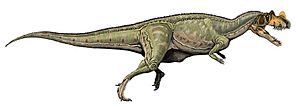
- †Diabloceratops: This "devil-horned face" dinosaur was a ceratopsian, related to Triceratops. It had two large horns above its eyes and a frill with spikes.
- †Eolambia: This was an early type of duck-billed dinosaur, or hadrosaur. It helps scientists understand how these famous dinosaurs evolved.
- †Falcarius: This strange dinosaur was an early therizinosaur. It had long claws and was one of the first known plant-eating theropods.
- †Gastonia: This armored dinosaur was a nodosaur, covered in rows of spikes and bony plates. It was a relative of Ankylosaurus.
- †Gryposaurus: A large duck-billed dinosaur, Gryposaurus is known for the prominent "Roman nose" bump on its snout.
- †Kosmoceratops: This horned dinosaur had one of the most elaborate frills and horn arrangements of any ceratopsian, with ten forward-curving hooks!
- †Lythronax: Meaning "gore king," this was an early tyrannosaur, a relative of T. rex. It was a fierce predator in the Late Cretaceous.
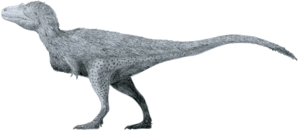
- †Moabosaurus: This sauropod dinosaur was discovered near Moab, Utah. It was a medium-sized long-necked dinosaur from the Early Cretaceous.
- †Nasutoceratops: This horned dinosaur had unusually long, forward-curving horns above its eyes, similar to a modern bull. Its name means "large-nosed horn face."
- †Nothronychus: This was a feathered, plant-eating theropod dinosaur with long claws. It was a type of therizinosaur.
- †Othnielosaurus: A small, agile plant-eating dinosaur that lived during the Late Jurassic. It was an early ornithopod.
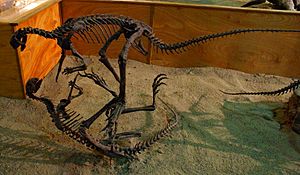
- †Parasaurolophus: This duck-billed dinosaur is famous for its long, hollow crest on its head, which it might have used for making sounds or display.
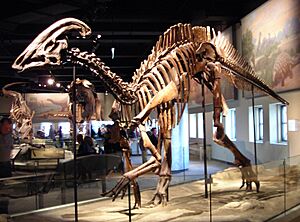
- †Seitaad: This early long-necked dinosaur was found in Utah. Its name comes from a Navajo word for a mythical monster that buried its victims in sand.
- †Siats: Named after a giant man-eating monster from Ute Indian folklore, Siats was a massive meat-eating dinosaur, one of the largest predators of its time.
- †Stegosaurus: This iconic dinosaur is known for the large bony plates along its back and the spiked tail it used for defense.
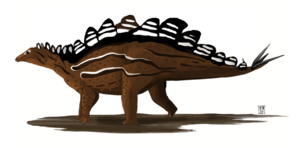
- †Talos: This small, bird-like dinosaur was a troodontid, a group of agile, intelligent predators. Its name comes from a giant robot from Greek mythology.
- †Teratophoneus: Another tyrannosaur from Utah, its name means "monstrous murderer." It was a powerful predator in the Late Cretaceous.
- †Triceratops: While more famous from other states, fossils of this three-horned dinosaur have also been found in Utah.
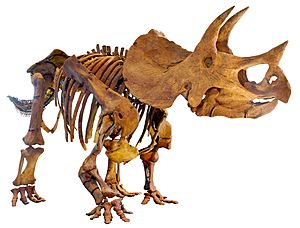
- †Utahceratops: This large horned dinosaur had a short horn over its nose and long, curving horns over its eyes. It was unique to Utah.
- †Utahraptor: This "Utah thief" was a large, fierce raptor dinosaur, much bigger than the famous Velociraptor. It had a huge sickle-shaped claw on each foot.
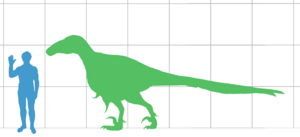
- †Venenosaurus: Meaning "poison lizard," this sauropod dinosaur was named after the Poison Strip Member of the Cedar Mountain Formation where it was found.
- †Yurgovuchia: This small, agile raptor dinosaur was another dromaeosaurid found in Utah, showing the diversity of raptors in the area.
Other Mesozoic Animals
Besides dinosaurs, Utah's Mesozoic environments were home to other interesting creatures:
- †Redondasaurus: This was a type of phytosaur, an ancient reptile that looked like a crocodile but was not closely related. They lived in rivers and lakes.
- †Inoceramus: These were giant marine clams that lived in the seas that covered parts of Utah during the Cretaceous period. Some grew to be very large!
- †Placenticeras: This was an ammonite, a type of shelled cephalopod related to modern squid. They had beautiful, coiled shells and lived in the ocean.
Cenozoic Era: The Age of Mammals
The Cenozoic Era began about 66 million years ago, right after the dinosaurs disappeared. This is often called the "Age of Mammals" because mammals became the dominant large animals on Earth.
Mammals and Other Cenozoic Life in Utah
Utah's landscapes changed a lot during the Cenozoic, from warm, swampy areas to cooler, drier environments.
- †Arctodus: Also known as the short-faced bear, this was a huge, powerful bear that lived during the Ice Age. It was one of the largest land predators of its time.
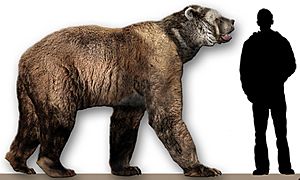
- †Camelops: This was an ancient camel that lived in North America during the Ice Age. It was much larger than modern camels.
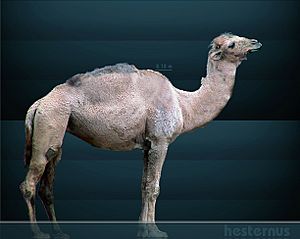
- †Coryphodon: This was a large, heavy mammal that lived in swamps during the Paleocene and Eocene epochs. It looked a bit like a hippopotamus.
- †Eobasileus: This huge, rhino-like mammal lived during the Eocene. It had several bony knobs and horn-like structures on its head.
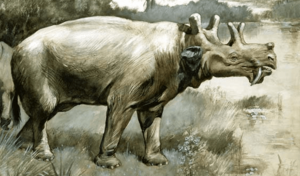
- †Euglossopteryx: This ancient bee fossil was found in Utah. It helps scientists understand the early history of insects and their relationship with flowering plants.
- †Hyaenodon: These were powerful, meat-eating mammals that lived from the Eocene to the Miocene. They were not true hyenas but looked similar.
- †Leptomeryx: This small, deer-like mammal lived during the Eocene and Oligocene. It was an early type of ruminant, meaning it chewed its cud.
- †Mammut (Mastodon) and †Mammuthus (Mammoth): Both of these giant elephant relatives lived in Utah during the Ice Age. Mastodons were browsers, eating leaves and twigs, while mammoths were grazers, eating grass.
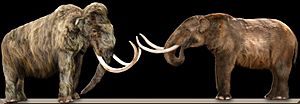
- †Megalonyx: This was a giant ground sloth that lived during the Ice Age. It was much larger than modern sloths and had huge claws.
- †Miacis: This small, agile mammal was an early ancestor of modern carnivores like cats and dogs.
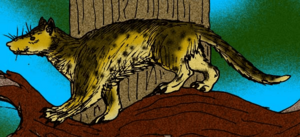
- †Paramylodon: Another type of giant ground sloth, Paramylodon was common in North America during the Ice Age.
- †Presbyornis: This ancient bird was an early waterfowl, related to modern ducks and geese. Its fossils help us understand bird evolution.
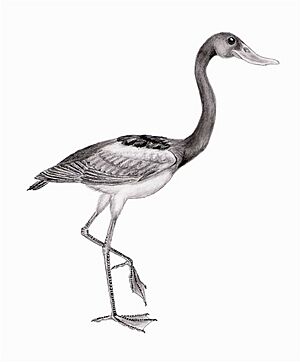
- †Smilodon: This is the famous saber-tooth cat, known for its incredibly long, sharp canine teeth. It was a powerful predator during the Ice Age.
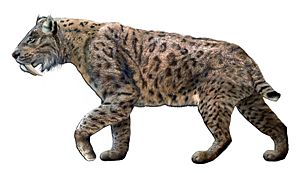
- †Stylinodon: This unusual mammal was a taeniodont, a group of extinct mammals with strong teeth for digging or eating tough plants.
- †Uintatherium: This massive, rhino-like mammal lived during the Eocene. It had three pairs of bony horns or knobs on its head and large saber-like canine teeth.
Images for kids
-
Fossil of the Cambrian trilobite Asaphiscus
-
Life restoration of the Carboniferous-Permian amphibian Eryops
-
Life restoration of the Permian Chimaera relative Helicoprion
-
Life restoration of the Late Jurassic theropod dinosaur Allosaurus
-
Life restoration of a herd of the Late Jurassic sauropod dinosaur Brontosaurus
-
Restoration of the Late Jurassic ceratosaur Ceratosaurus
-
Life restoration of the Late Cretaceous tyrannosaur Lythronax
-
Mounted fossilized skeleton of the Late Jurassic herbivorous dinosaur Othnielosaurus
-
Mounted fossilized skeleton of the Late Cretaceous duck-billed dinosaur Parasaurolophus
-
Restoration of the Late Jurassic stegosaur Stegosaurus
-
Mounted fossilized skeleton of the Late Cretaceous horned dinosaur Triceratops
-
Diagram illustrating the Early Cretaceous dromaeosaurid ("raptor") Utahraptor with an anachronistic human to scale
-
Restoration of an Arctodus, or short-faced bear, with a human to scale
-
Life restoration of the Pliocene-Holocene camel Camelops
-
Life restoration of a pair of the Eocene uintathere mammal Eobasileus. Charles R. Knight (1890s).
-
Life restorations of a Mammut americanum, or American mastodon (right), and a Mammuthus primigenius, or wooly mammoth (left)
-
Life restoration of the Paleocene-Eocene mammal Miacis
-
Fossilized skeleton of the Pliocene-Pleistocene ground sloth Paramylodon
-
Life restoration of the Paleocene-Eocene waterfowl Presbyornis
-
Life restoration of the Pleistocene-Holocene saber-tooth cat Smilodon


